Materials Sciences and Applications
Vol.4 No.9(2013), Article ID:36664,5 pages DOI:10.4236/msa.2013.49063
Plant Seeds-Based Dye-Sensitized Solar Cells
![]()
1Chemistry Department, Islamic University of Gaza, Gaza, Palestinian Authority; 2Physics Department, Islamic University of Gaza, Gaza, Palestinian Authority.
Email: *staya@iugaza.edu.ps
Copyright © 2013 Monzir S. Abdel-Latif et al. This is an open access article distributed under the Creative Commons Attribution License, which permits unrestricted use, distribution, and reproduction in any medium, provided the original work is properly cited.
Received July 3rd, 2013; revised August 2nd, 2013; accepted August 13th, 2013
Keywords: Renewable Energy; Dye Sensitized Solar Cells; Natural Dyes; Plant Seeds
ABSTRACT
In this work, we investigate the performance of dye-sensitized solar cells (DSSCs) based on natural dyes extracted from ten different plant seeds. The extracts were characterized by UV-VIS absorption spectra. The solar cells were assembled using a TiO2 mesoporous film on FTO-coated glass. The photovoltaic properties of the DSSCs were studied under an incident irradiation of 100 mW/cm2. The best performance was for the DSSC sensitized with Eruca sativa with a solar energy conversion efficiency of 0.725%. Moreover, the validity of these extracts was compared using two types of semiconductor layers (TiO2 and ZnO), and finally the photovoltaic properties of one of these dyes were studied using different types of electrolytes.
1. Introduction
Dye-sensitized solar cells (DSSCs) have attracted considerable attention since its invention by Michael Grätzel et al. in 1991 [1]. This attention is due to its environmental friendliness, low cost, and simple fabrication, relative to the more established technologies based on monocrystalline Si and nanocrystalline thin-film solar cells. The main idea of DSSCs is to use a wide band gap but cheap metal oxide semiconductor such as TiO2, which is sensitized by a dye that separates the light absorption process from the charge collection process, mimicking natural light harvesting procedures in photosynthesis, by combining dye sensitizers with semiconductors. To be effective, it requires the highest occupied molecular orbital (HOMO) of the dye to reside in the band gap of the semiconductor and its lowest unoccupied molecular orbital (LUMO) to lie within the conduction band of the semiconductor. The conversion efficiency is determined by two main factors: 1) the short circuit photocurrent density, Jsc, and 2) the open circuit potential, Voc.
Natural dyes, which can be extracted from fruits, flowers, seeds, and leaves of plants by simple procedures, have attracted more and more interest [2-12]. It has been shown by many researches that natural dyes play a key role in harvesting sunlight and transferring solar energy into electric energy [13,14].
Recently Calogero et al. reported that a conversion efficiency of 0.66% was obtained using red sicilian orange juice dye as sensitizer [10]. Wongcharee et al. employed rosella as sensitizer which achieved a conversion efficiency of 0.70% [8]. Roy et al. indicated that using Rose Bengal dye resulted in 2.09% conversion efficiency [9].
In this paper, ten natural dyes were extracted from plant seeds. These seeds are inexpensive, have no nutritional use, and are abundant in Palestine. The extracted dyes were characterized by UV-VIS absorption spectroscopy. The photoelectrochemical properties of the fabricated DSSCs using these extracts as sensitizers were investigated. The photovoltaic properties of DSSCs sensitized by the purified products were studied. Also the validity of some of these extracts was compared using two different metal oxides. The performance of the best cell was studied using different types of iodide salts.
2. Experiment
2.1. Preparation of Natural Dye Sensitizers
Ten plant dry seeds were used: Alkanna tinctoria (Tausch), Linum usitatissimum, Acacia, Terminalia chebula, Ocimum basilicum, Radish, Eruca sativa, Fumaria officinalis, Amomum granum paradisi, and Ammi. These seeds were washed with distilled water, dried at 60˚C for 24 hrs, and then grinded into fine powder using a mortar. One gram of the prepared powder was added to 10 ml of ethanol as a solvent. After 24 h they were filtered, then concentrated at 60˚C to a final volume of 3 ml.
2.2. Preparing and Assembling the Cell
FTO conductive glass sheets of dimensions 1 cm × 1 cm with sheet resistance of 15 Ω/cm2 and transmission >80% (Xinyan Tech. Ltd, Hong Kong) were first cleaned using an ultrasonic bath for 15 min, rinsed with water, ethanol, and then dried. A plastic adhesive tape was fixed on three sides of the conductive glass sheet to restrict the thickness and area of the TiO2 film. TiO2 paste was prepared by grinding 50 mg of TiO2 nanopowder with size 10 - 25 nm (US Research Nanomaterial, Inc, USA) with 50 mg of polyethylene glycol in a mortar for half an hour until a homogeneous paste was obtained. An area of 0.25 cm2 of TiO2 paste was spread onto the conductive glass sheet using a glass rod and dried for 30 min at 60˚C. Finally, the TiO2 film was sintered at 450˚C for 30 min to solidify the paste. After cooling to a temperature of 60˚C, the conductive glass solidified TiO2 film was immersed in an alcoholic solution of the natural dye sensitizer for 24 h to adsorb the dye on the TiO2 porous film adequately.
The DSSC was assembled by filling a liquid electrolyte between the sensitized TiO2 porous film electrode (photoanode) and a conductive glass sheet plated with platinum (Pt) (cathode, prepared by electrodeposition). The electrolyte solution is composed of 2 ml acetonitrile (ACN), 8 ml propylene carbonate (p-carbonate), 0.668 gm potassium iodide, KI, and 0.0634 gm iodine, I2. Then the two electrodes were clipped together to form the DSSC.
2.3. Measurements
The absorption spectra of ten dye solutions were recorded using a UV-VIS spectrophotometer (Thermoline Genesys 6). The absorption analysis was conducted in the wavelength range from 350 to 800 nm. The I-V characteristic curves under simulated sunlight (AM1.5, 100 mW/cm−2) were conducted using National Instruments data acquisition card (USB NI 6251) in combination of a Labview program. Based on I-V curve, the fill factor (FF) can be calculated as
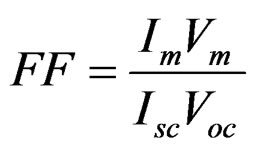 (1)
(1)
where Im and Vm are the photocurrent and photovoltage for maximum power output (Pm), Isc and Voc are the short-circuit photocurrent and open-circuit photovoltage, respectively.
The overall energy conversion efficiency (η) is defined as
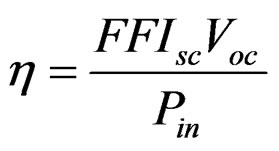 (2)
(2)
where Pin is the power of incident light.
3. Results and Discussions
Figure 1 shows the absorption spectra of Fumaria officinalis (A) and Ocimum basilicum (B) extracts using ethyl alcohol as a solvent. As can be seen from the figure, Fumaria officinalis extract has an absorption peak in the visible region at 750 nm whereas the absorption peak of Ocimum basilicum extract is at 654 nm.
The I-V characteristic curves of all cells were carried out under illumination with white light of intensity 100 mW/cm2 from a high pressure mercury arc lamp. Figure 2 presents the I-V characteristic curves for some dyes: Radish, Fumaria officinalis, Eruca sativa, and Ocimum basilicum. The DSSC output power has been calculated as P = I∙V using the I-V data corresponding to each cell and plotted as a function of V, as shown in Figure 3. The maximum power (Pm) point for each cell is then determined from Figure 3. The photocurrent (Im) and photovoltage (Vm) corresponding to the maximum power point were then obtained. The values of the fill factor and the cell conversion efficiency were calculated. Results are summarized in Table 1. As can be seen from the table, the short circuit current density has a minimum value of 0.17 mA/cm2 and a maximum value of 2.9 mA/cm2 for the DSSCs sensitized with Alkanna tinctoria and Eruca sativa extracts, respectively. The open circuit voltage ranges between 0.38 for the DSSC sensitized with the extract of Alkanna tinctoria and 0.66 V for the cell dyed with Radish. The fill factor of the fabricated cells changes from 31% and 51%. The highest fill factor was obtained for the DSSC sensitized with the extract of Fumaria officinalis. The highest output power and conversion efficiency were obtained for the DSSC sensitized with Eruca sativa extract where the efficiency of the cell reached 0.72%.
These results are similar to those of the DSSCs sensitized by other natural dyes in previous works [4-7]. Moreover, Table 1 shows the photoelectrochemical pa-
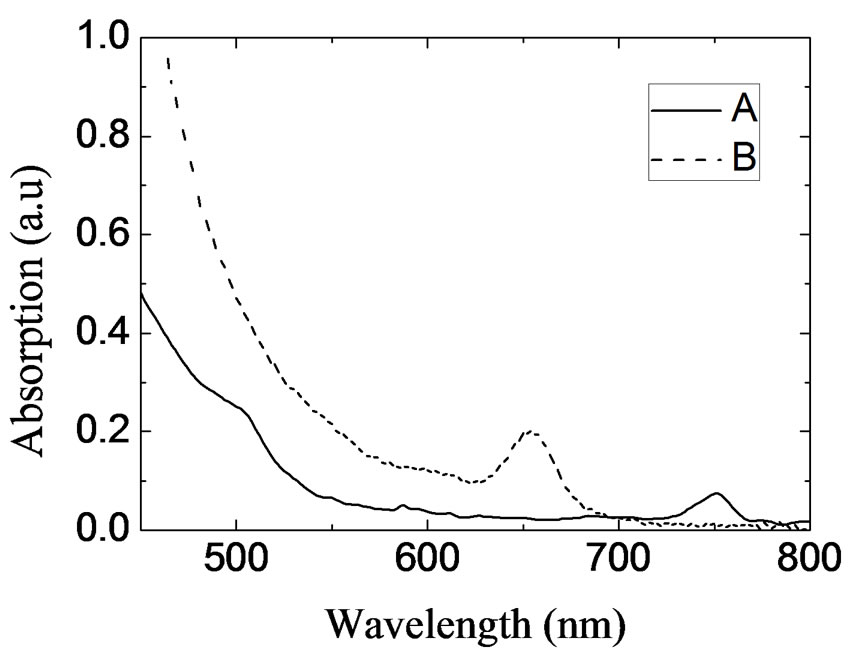
Figure 1. The absorption spectra of the extracts of Fumaria officinalis (A) and Ocimum basilicum (B) using ethyl alcohol as solvent.
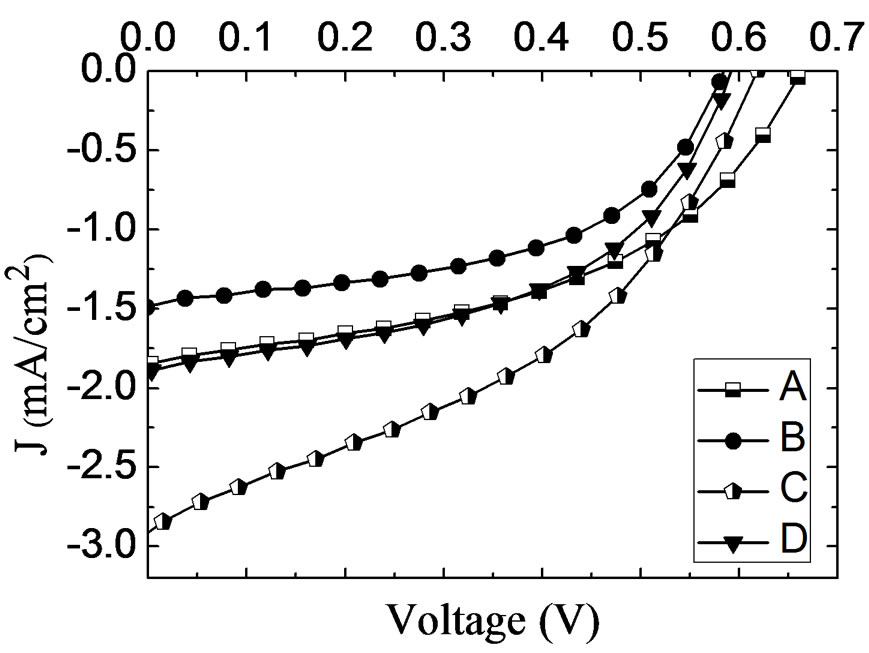
Figure 2. I-V characteristic curves for the DSSCs sensitized by Radish (A), Fumaria officinalis (B), Eruca sativa (C), and Ocimum basilicum (D) under the illumination with white light of intensity 100 mW/cm2.
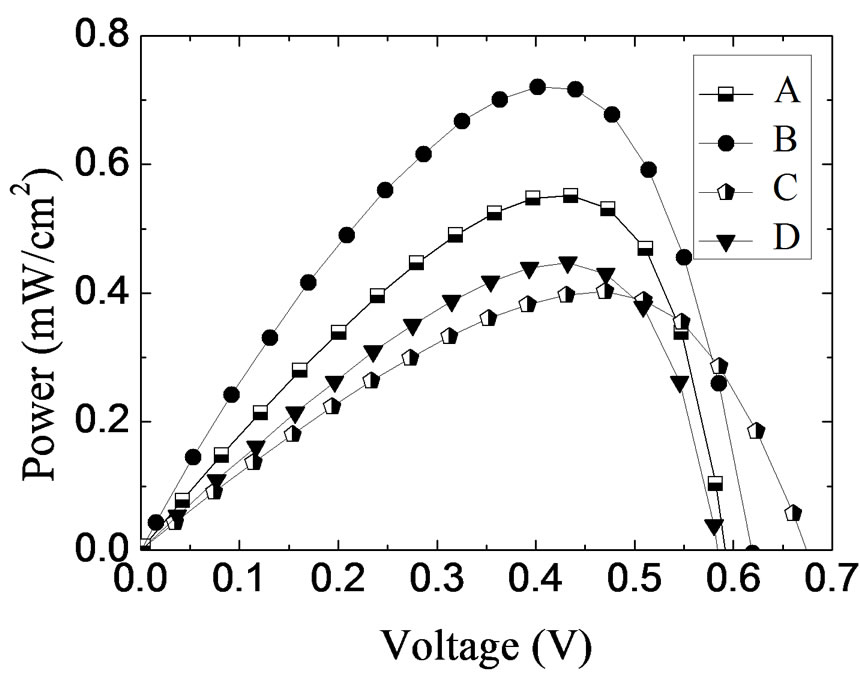
Figure 3. Power versus voltage curves for the DSSCs sensitized by Ocimum basilicum (A), Eruca sativa (B), Radish (C), and Fumaria officinalis (D).
rameters of the DSSC sensitized with Ru complex, cis-dicyano-bis(2,2’-bipyridyl-4,4’-dicarboxylic acid) ruthenium(II), Ruthenizer 505, (Solaronix, Switzerland), which is widely used in DSSCs. As can be seen, Voc of the DSSCs sensitized with the extracts of Ocimum basilicum, Radish, Eruca sativa, Fumaria officiralis, and Ammi are very close to that of the DSSC sensitized by the Ru complex. In addition, the fill factors obtained in this work for the DSSCs sensitized with Linum usitatissimum, Ocimum basilicum, and Fumaria officinalis are comparable to that of the DSSC sensitized by the Ru complex. The low efficiency of the fabricated cells, compared to that sensitized by the Ru complex, is mainly attributed to the low short circuit current.
TiO2 nanoparticle films have been widely investigated for DSSCs. However, it was reported that TiO2 films have some defects such as lack of a large enough energy barriers between the interface of the films and electrolytes and the existence of plenty of electron-trapped surface states, which is the cause of recombination [15]. The photocatalytic activity of TiO2 is so high under the UV radiation of natural sun-light that organic materials in DSSCs may be decomposed during outdoor use, resulting in long-term reliability problems for the conversion efficiency. Hence, some investigations have been turned to ZnO films, which have a much lower photocatalytic activity and less electron-trapped surface states [16].
In the next step of this work, the performance of some of our dyes using ZnO semiconducting films was investtigated. DSSCs were prepared with ZnO as a thin film semiconducting layer instead of TiO2 using the same procedure described before. Three extracts (Ocimum basilicum, Eruca sativa, and Radish) were selected as sensitizing dyes. Figure 4 illustrates the I-V characteristic curves for the DSSCs using ZnO as a thin film sensitized by natural dyes extracted from the seeds of Ocimum basilicum, Eruca sativa, and Radish, at light intensity of 100 mW/cm2. The Photoelectrochemical parameters of these cells are presented in Table 2. These parameters are much less than those listed in Table 1 for the same extracts. As Table 2 shows, Jsc changes in the range from 0.41 to 1.05, Voc varies from 0.34 to 0.36, and the conversion efficiency changes from 0.02 to 0.09. When using TiO2 as a semiconducting layer, the DSSC sensitized with Ocimum basilicum exhibit a conversion efficiency of 0.56% where its efficiency has declined to 0.02% when using ZnO. In a similar manner, the DSSC sensitized with Eruca sativa shows a decrease in the efficiency from 0.72% to 0.07%. When using Radish as a sensitizing dye, the decrease in efficiency was from 0.56% to 0.09%. It is clear that the cells exhibit much better performance in photoelectric conversion efficiency when using TiO2 as a semiconducting layer as compared to ZnO thin films.
Finally, the performance of the DSSC sensitized with Eruca sativa using different types of iodide salts was investigated. The electrolyte plays a significant role in the operation of the DSSC. At the counter-electrode the electron is transferred to triiodide in the electrolyte to yield iodide ions, which in turn reduce the oxidized dye to its original state. The performance of the DSSC sensi-
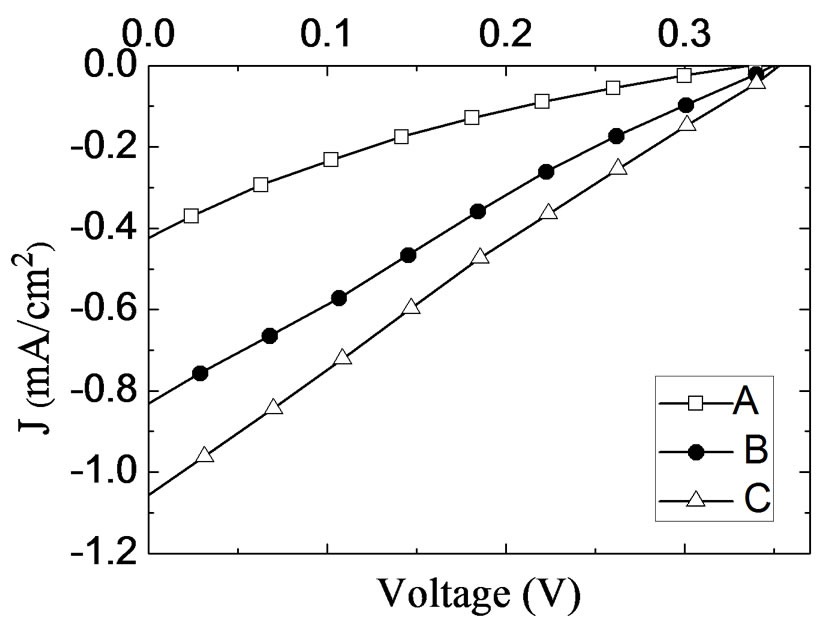
Figure 4. I-V characteristic curves for the DSSCs containing ZnO as a semiconducting layer and sensitized by the extracts of Ocimum basilicum (A), Eruca sativa (B), and Radish (C) under the illumination with white light of intensity 100 mW/cm2.
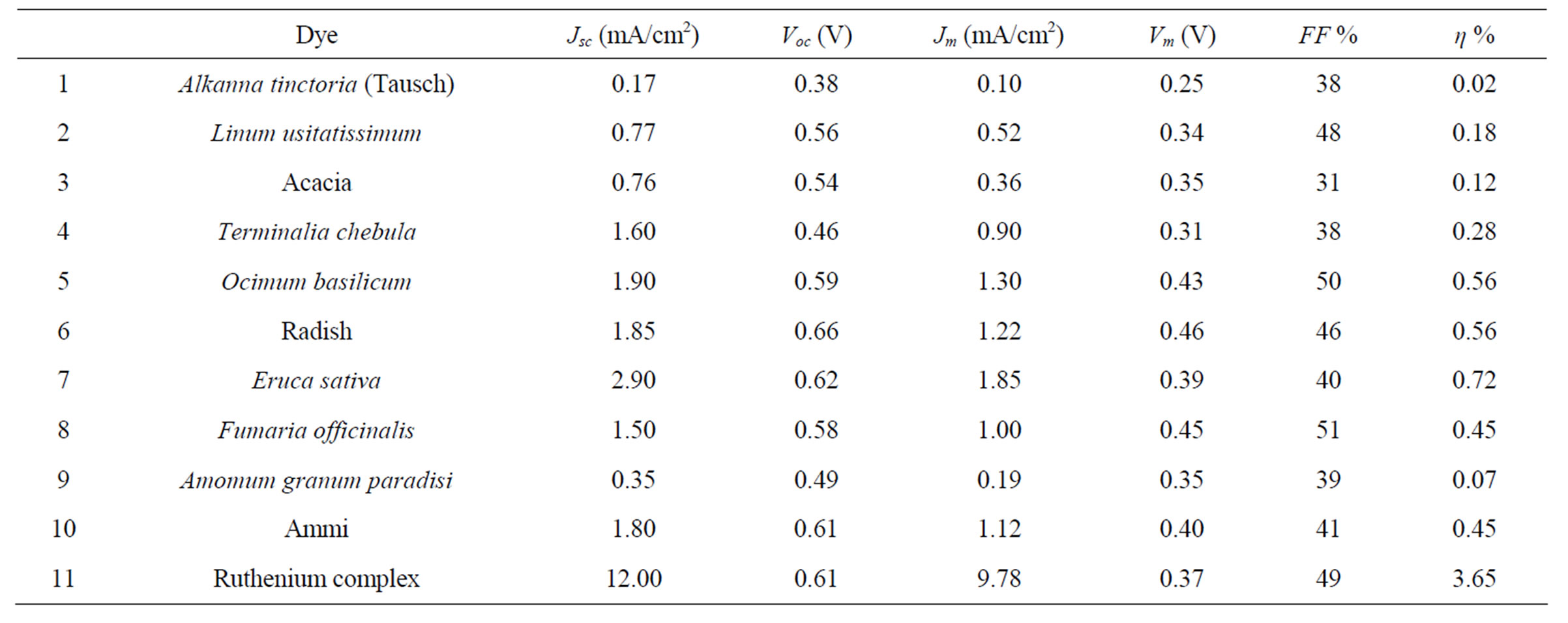
Table 1. Photocurrents (Jsc, Jm), photovoltages (Voc, Vm), fill factor, and overall energy conversion efficiency for ten DSSCs sensitized by dyes extracted from seeds

Table 2. Photoelectrochemical parameters of the DSSCs sensitized by various natural dyes when using ZnO nanoparticle as a semiconductor.
tized with Eruca sativa is now examined for three different salts (NaI, KI, LiI) using the TiO2 porous film. The I-V characteristic curves of the DSSCs for the three electrolytes are represented in Figure 5. From the figure we can rank the performance of the three electrolytes as LiI > KI > NaI. The calculations of the photoelectric properties are summarized in Table 3. Comparing the results presented in Table 1 for the cell sensitized with Eruca sativa with those in Table 3 we find that the efficiency of the cell has been doubled when LiI was used as an electrolyte.
4. Conclusion
Dye sensitized solar cells were fabricated using TiO2 and ZnO semiconducting materials. These cells were sensitized using natural dyes extracted from plant seeds. The extracted dyes were characterized by UV-VIS absorption spectra. The I-V characteristic curves were measured and the photoelectrochemical properties were investigated. The highest conversion efficiency was obtained for the DSSC fabricated using TiO2 sensitized by Eruca sativa extract using  as an electrolyte, where the efficiency of the cell reached 1.6%. The open circuit voltage of the DSSCs sensitized with the extracts of Ocimum basilicum, Radish, Eruca sativa, Fumaria officinalis, and Ammi is very close to that of the DSSC sensitized by
as an electrolyte, where the efficiency of the cell reached 1.6%. The open circuit voltage of the DSSCs sensitized with the extracts of Ocimum basilicum, Radish, Eruca sativa, Fumaria officinalis, and Ammi is very close to that of the DSSC sensitized by
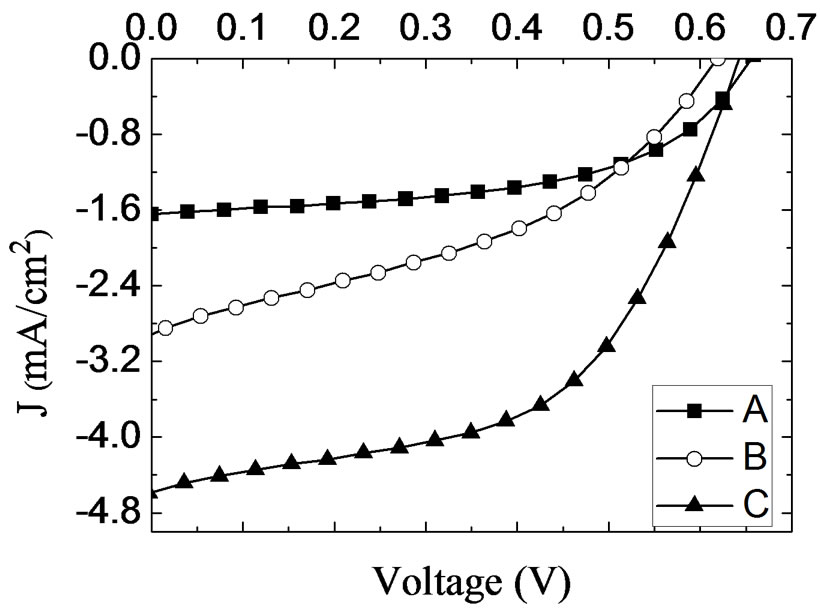
Figure 5. I-V characteristic curves for the DSSC sensitized with the extract of Eruca sativa using different types of electrolytes NaI (A), KI (B), and LiI (C) at light intensity of 100 mW/cm2.

Table 3. Photoelectrochemical parameters of the DSSCs sensitized by Eruca sativa using different types of electrolytes.
the Ru complex. It is found that when using TiO2 as a semiconducting layer, the cells exhibit much better performance in photoelectric conversion of light than using ZnO. Moreover, it is found that the electrolyte has a crucial rule in the response of the cell. The efficiency of the DSSC sensitized with Eruca sativa is found to double when using  as an electrolyte.
as an electrolyte.
5. Acknowledgements
The authors would like to express gratitude to the scientific research affairs at the Islamic university of Gaza for the financial support of this work under the team work grant for the academic year 2011-2012.
REFERENCES
- B. O’Regan and M. Grätzel, “A Low-Cost, High-Efficiency Solar Cell Based on Dye-Sensitized Colloidal TiO2 Films,” Nature, Vol. 353, No. 6346, 1991, pp. 737- 740. doi:10.1038/353737a0
- S. Ito, T. Saitou, H. Imahori, H. Ueharad and N. Hasegawad,” Fabrication of Dye-Sensitized Solar Cells Using Natural Dye for Food Pigment: Monascus Yellow,” Energy & Environmental Science, Vol. 3, No. 2, 2010, pp. 905-909. doi:10.1039/c000869a
- T. El-Agez, A. El Tayyan, A. Al-Kahlout, S. A. Taya and M. S. Abdel-Latif, “Dye-sensitized Solar Cells Based on ZnO Films and Natural Dyes,” International Journal of Materials and Chemistry, Vol. 2, No. 3, 2012, pp. 105- 110.
- S. Hao, J. Wu,Y. Huang and J. Lin, “Natural Dyes as Photosensitizers for Dye-Sensitized Solar Cell,” Solar Energy, Vol. 80, No. 2, 2006, pp. 209-214. doi:10.1016/j.solener.2005.05.009
- T. Chou, Q. Zhang and G. Cao, “Effects of Dye Loading Conditions on the Energy Conversion Efficiency of ZnO and TiO2 Dye-Sensitized Solar Cells,” The Journal of Physical Chemistry C, Vol. 111, No. 50, 2007, pp. 18804- 18811. doi:10.1021/jp076724f
- S. Taya, T. El-Agez, H. El-Ghamri and M. Abdel-Latif, “Dye-Sensitized Solar Cells Using Fresh and Dried Natural Dyes,” International Journal of Materials Science and Applications, Vol. 2, No. 2, 2013, pp. 37-42. doi:10.11648/j.ijmsa.20130202.11
- H. Zhou, L. Wu, Y. Gao and T. Ma, “Dye-Sensitized Solar Cells Using 20 Natural Dyes as Sensitizers,” Journal of Photochemistry and Photobiology, Vol. 219, No. 2, 2011, pp. 188-194. doi:10.1016/j.jphotochem.2011.02.008
- K. Wongcharee, V. Meeyoo and S. Chavadej, “Dye-Sensitized Solar Cell Using Natural Dyes Extracted from Rosella and Blue Pea Flowers,” Solar Energy Materials and Solar Cells, Vol. 91, No. 1, 2007, pp. 566-571. doi:10.1016/j.solmat.2006.11.005
- M. Roy, P. Balraju, M. Kumar and G. Sharma, “DyeSensitized Solar Cell Based on Rose Bengal Dye and Nanocrystalline TiO2,” Solar Energy Materials and Solar Cells, Vol. 92, No. 2, 2008, pp. 909-913. doi:10.1016/j.solmat.2008.02.022
- G. Calogero and G. Marco, “Red Sicilian Orange and Purple Eggplant Fruits as Natural Sensitizers for DyeSensitized Solar cells,” Solar Energy Materials and Solar Cells, Vol. 92, No. 1, 2008, pp. 1341-1346. doi:10.1016/j.solmat.2008.05.007
- T. Lin, J. Lin, Sh. Tsai, J. Lee and Ch. Ting, “Absorption Spectra Analysis of Natural Dyes for Applications in Dye-Sensitized Nano Solar Cells,” The 31st National Conference on Theoretical and Applied Mechanics, Vol. 96, No. 12, 2007, pp. 21-22.
- Q. Dai and J. Rabani, “Photosensitization of Nanocrystallinetio2 Films by Anthocyanin Dyes,” Journal of Photochemistry and Photobiology A: Chemistry, Vol. 26, No. 2, 2002, pp. 421-429.
- M. Gratzel, “Dye-Sensitized Solar Cells,” Journal of Photochemistry and Photobiology C: Photochemistry Reviews, Vol. 4, No. 1, 2003, pp. 145-153. doi:10.1016/S1389-5567(03)00026-1
- K. Tennakone, A. Kumarasinghe and G. Kumara, K. Wijayantha and P. M. Sirimanne, “Nanoporous TiO2 Photoanode Sensitized with the Flower Pigment Cyaniding,” Journal of Photochemistry and Photobiology, Vol. 108, No. 2, 1997, pp. 193-198.
- Z. Longyue, D. Songyuan, X. Weiwei and W. Kongjia, “Dye-Sensitized Solar Cells Based on ZnO Films,” Plasma Science & Technology, Vo1. 8, No. 2, 2006, pp. 172-175.
- C. Bmer, G. Boschloo and A. Hagfe, “Electron Injection and Recombination in Ru(dcbpy)2(NCS)2 Sensitized Nanostructured ZnO,” The Journal of Physical Chemistry B, Vol. 105, No. 2, pp. 5585-5838.
NOTES
*Corresponding author.

